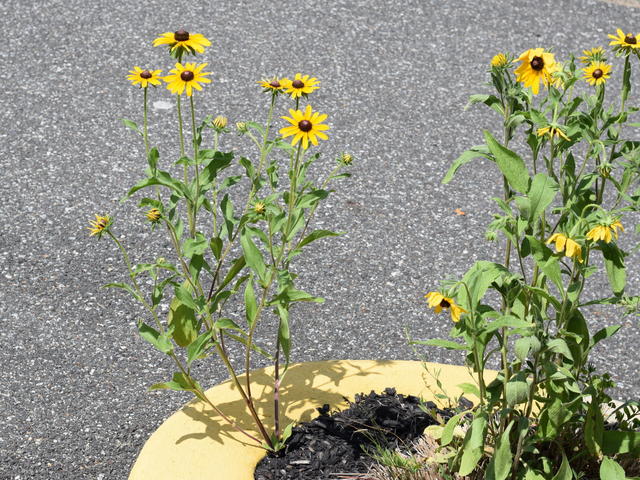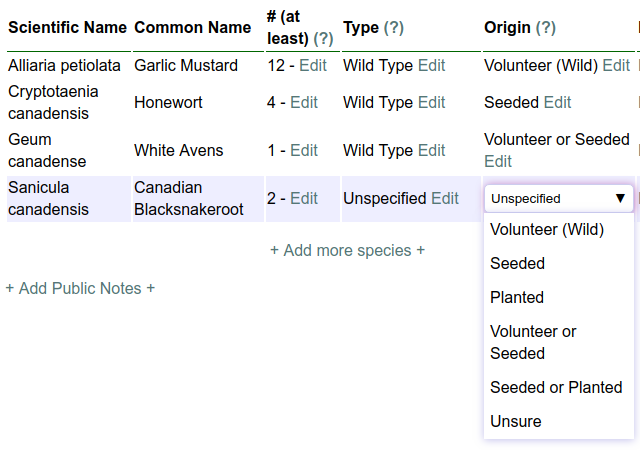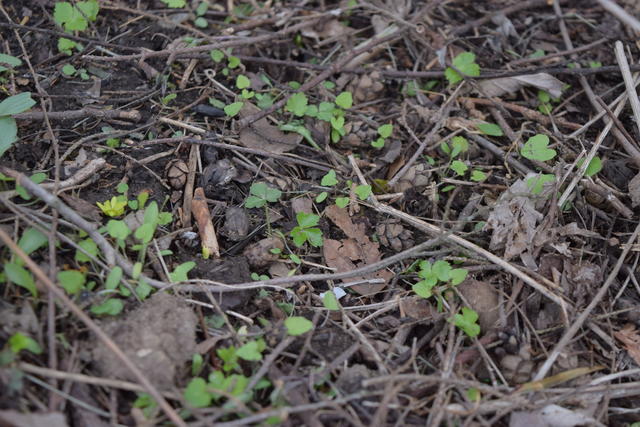How We Handle Wild vs Cultivated Plants
April 16th, 2019 by Alex Zorach
Our world is filled with a mix of wild and cultivated plants, with a complex interplay between them. Humans grow gardens and plants for agriculture, and weeds pop up amongst them. The same species (such as Brassica rapa) might be a cultivated plant in one field, and a weed in another. Plants routinely escape population and become naturalized. Cultivated plants in gardens and agriculture are a major source of both invasive species and populations of native plants.The concept of an organism being wild, or in its natural state, is an important one, but there is no single agreed-upon definition or way to determine objectively whether or not a specific organism is truly wild. There can also be a large gray area between wild and natural. iNaturalist, a website and app for documenting any organisms, instructs people in their guidelines to report organisms that are not cultivated or in capitivity, but they give little explanation of what this means or how to handle border cases.
iNaturalist's approach is to assume reports are wild by default, and allow people to flag things as not wild in a "data quality assessment" after the fact. We find this approach inadequate for several reasons. For one, marking the data wild by default results in many reports of cultivated plants slipping through under the assumption that they are wild. For example, there are abundant reports of plants from Manhattan, NYC, and other urban areas, not even in parks, that are clearly landscaping plants based on their pictures and/or locations, but few of these reports have been marked as not wild.
 These Rudbeckia hirta flowers illustrate how complex the idea of "wild" is. They are the offspring of plants that came up as volunteers in an urban area and were transplanted into this bed. They might be indistinguishable from wild plants, were they not growing in a mulch bed in a parking lot. Both plants here sprouted from seed in a spot where they were not originally planted; the leftmost plant directly against the curb, the rightmost plant inside a clump of ornamental grass. Are these plants "wild" or not?
These Rudbeckia hirta flowers illustrate how complex the idea of "wild" is. They are the offspring of plants that came up as volunteers in an urban area and were transplanted into this bed. They might be indistinguishable from wild plants, were they not growing in a mulch bed in a parking lot. Both plants here sprouted from seed in a spot where they were not originally planted; the leftmost plant directly against the curb, the rightmost plant inside a clump of ornamental grass. Are these plants "wild" or not?A second problem is the numerous border cases. If a plant escapes cultivation and survives in the wild, but clearly retains characteristics of cultivated plants (such as altered flower shape or color, or variegated leaves), is that plant wild? What about plants that come up on their own, from a wild population, but that people transplant into their gardens? And perhaps most importantly, what if you don't know, that is, you observe a plant but you cannot tell whether or not it is cultivated? This is the case for a large number of trees in suburban areas and parks, especially on the borders between yards or gardens and wild areas.
When we consider these things, we realize that there are two different aspects of a plant: the characteristics of the plant itself (including both genotype and phenotype) and whether or not the plant has been planted intentionally. We also realize that it is important to allow users to specify: "I don't know." for a large number of these plants.
Here we explain our way of handling these things.
Separate the organism's characteristics from its origin
Rather than using a single field to track whether or not a plant is wild, we have separated this information into two fields. One is the organism type, which tracks whether or not the plant has characteristics of a wild organism. The other we call the origin, which tracks whether the plant was planted, seeded, or a volunteer (i.e. it came up on its own).Assume nothing: let users specify additional information if they are able and willing
Our approach, contrasting with iNaturalist, is to assume nothing about an organism's wildness by default. When a user reports a plant observation on our site, by default, we leave as unspecified the fields tracking whether or not the organism is wild. This screenshot shows how our system displays and handles reporting of the two fields for tracking the degree to which organisms are wild. All records are marked "unspecified" to start, and can be updated by the user to specify additional information.
This screenshot shows how our system displays and handles reporting of the two fields for tracking the degree to which organisms are wild. All records are marked "unspecified" to start, and can be updated by the user to specify additional information.Users can then specify this information themselves, if they want to. We also provide online help documentation to clarify exactly what these fields mean. The path of least resistance is to leave these fields unspecified.
Furthermore, users also have the option of selecting "Unsure" for either or both fields.
Contrasting with iNaturalist, we actively encourage users to report non-wild organisms. We explain below how and why tracking of these reports is important for science and conservation purposes. A lot of this importance stems from the fact that cultivated plants can and do escape into the wild. We want to be able to track and study the interactions between wild and cultivated plants.
What the organism type field tells us
The organism type field has four settings: Wild Type, Intermediate, Cultivar, and Unsure. The organism type describes an organism's phenotype, or observable characteristics. It does not necessarily reflect the organism's genetics. Because our website focuses on easily-observable plant characteristics, we do not have any field for reporting the genotype.A wild type organism is one that looks indistinguishable from wild organisms. This doesn't necessarily mean that it is a truly wild organism. It might be a cultivar that has characteristics that fall well within the range of plants in the wild. It might be descended from cultivars (and a genetic test might be able to verify this) but its easily observable characteristics make it indistinguishable from a wild plant. It might also be a plant taken from a wild population and grown in a garden. The important thing is that it looks like a wild plant, i.e. if you grew it alongside wild plants, it would not be visibly out of place in any way.
 "Chocolate Snakeroot" is a cultivar of White Snakeroot (Ageratina altissima) with dark purple-bronze leaves, contrasting with the solid green leaves of wild-type plants. It frequently escapes into the wild, usually reverting back to intermediate forms for the first few generations.
"Chocolate Snakeroot" is a cultivar of White Snakeroot (Ageratina altissima) with dark purple-bronze leaves, contrasting with the solid green leaves of wild-type plants. It frequently escapes into the wild, usually reverting back to intermediate forms for the first few generations.A cultivar is an organism that has clearly been modified or selected in some way shape or form, to have characteristics outside the range of wild plants. This often includes larger, showier flowers, and it may also include characteristics such as variegated or colored leaves, more compact growth habit, or sterility (inability to produce fertile seeds.) Cultivars are typically sold in nurseries and garden centers as named varieties of plants, and in many nurseries, they make up the bulk of the stock.
The intermediate category is for plants that are clearly descended from cultivars, but have begun to revert back to their wild forms. An example would be a seedling of plants from a dark-red-leaved cultivar of a plant, that has retained a significant reddish hue, when wild plants never have that hue, but showing less of these characteristics than the original cultivar. Intermediate plants are common as volunteer plants in a garden, in first or second generations of plants descended from cultivars. They are also relatively common in naturalized populations descended from garden plants.
The unsure category is self-explanatory, and is for cases where you do not know whether or not a plant is a cultivar. This option is probably the best choice for plants that might be cultivated, but when you have not observed them through the whole season, so you have not seen them flower, set seed, or complete their whole life cycle. "Unsure" is not the same as unspecified: it gives us the additional information that a user took the time to set the organism type field, but didn't know how to set it for this particular plant.
What the origin field tells us
The origin field of an observation captures independent information from the organism type. It describes how a plant got to where it was observed. The three main choices are Volunteer (Wild), Seeded, or Planted.Volunteer (Wild) means that a plant germinated on its own, by natural processes, and that it was not moved or transplanted by humans. It may or may not be a wild type plant, in that it may be descended either from a wild or cultivated population. The presence of volunteer plants establishes that there is either a source population nearby, or that the plant was present in the seed bank (perhaps from a past population that has since been eradicated). Volunteer plants also provide information about habitat and seed distribution: it means that natural processes were able to distribute the seed to the location where the plant was observed, and the conditions were right for its germination and survival.
Seeded means that humans planted or distributed the seed of a plant, but the plant germinated on its own. It was not planted by humans. Seeded plants do not provide information about nearby source populations, presence in a seed bank, or natural distribution mechanisms. However, these observations do provide information about the habitat and conditions being right for germination and survival.
Planted means that the plants were planted, after germination, by humans. If a plant was planted, it provides even less information about habitat, populations, and seed distribution. There may be no local source population, there may be no natural process that would distribute seed to the area, and the habitat and conditions may be such that even if the seed got there, it would not germinate on its own. Many plants can grow (and thrive) in conditions where they would not naturally germinate, and adult plants can often survive in a wider range of conditions than seedlings.
 This photo shows a variety of seedlings coming up in exposed soil in a small, semi-wild area surrounded by parking lots and suburban yards. The honewort (Cryptotaenia canadensis) was seeded here, which is relevant because this area is geographically separated from local populations of this species, which naturally occurred only along streams, and the plant probably would not have seeded in on its own. On the other hand, the garlic mustard (Alliaria petiolata) was already present here without being planted or seeded. All of these pieces of information are relevant to the study of these species and their populations and habitat requirements.
This photo shows a variety of seedlings coming up in exposed soil in a small, semi-wild area surrounded by parking lots and suburban yards. The honewort (Cryptotaenia canadensis) was seeded here, which is relevant because this area is geographically separated from local populations of this species, which naturally occurred only along streams, and the plant probably would not have seeded in on its own. On the other hand, the garlic mustard (Alliaria petiolata) was already present here without being planted or seeded. All of these pieces of information are relevant to the study of these species and their populations and habitat requirements.In addition to these three main categories, we also have two hybrid categories for situations where someone has partial, but incomplete information about a plant's origin. Volunteer or Seeded is for plants a person knows not to be planted, but is unsure whether or not the seed got there on its own or was planted or distributed by humans. This category still tells us that the habitat and conditions were right for the plant to germinate and survive. There is also a Seeded or Planted category, for plants we know to be human in orgin, but where we're not sure whether or not they were planted as seeds or an adult. And, of course, there is still an unsure category.
Additional aspects of wildness to consider in the future
We are open to feedback and discussion about the best ways to report and handle observations, in order to refine the system we have put into place. One future consideration is the specification of area-level management practices. This could be useful for specifying areas as flower beds, mowed lawns, or wild areas, and for distinguishing unmanaged wild areas for areas managed in a variety of ways (such as once-a-season mowing, management for native plants, herbicide use, pruning or trimming of edges, or anything else that would affect plant growth.) This data will likely not live in the records for each observation, but rather, could be specified separately and then displayed automatically across different observations made in the area.Another consideration on the level of individual observations is to add a field for users to report a plant that they have killed or removed after it was observed. As such, someone weeding a garden could report and identify the weeds before killing them, and people could do something similar when removing invasive species from a nature preserve or other wild area. We may also want to explore ways to report natural deaths of plants, such as if they are killed by drought, flooding, herbivory or disease, or competition from other plants.
In summary
We have decided to resolve or handle the classification of plant observations as wild vs. cultivated by breaking the concept of wild into two separate fields: organism type and origin. The organism type field handles whether an organism's phenotype is of the wild type, a cultivar, or an intermediate form. The origin field handles whether a plant was a volunteer (came up on its own through natural processes), was seeded by humans, or planted by humans. Both fields default to unspecified, and users can select "Unsure" when specifying them.These options will help ensure that our data has maximal usefulness for research purposes, providing valuable information about source populations and seed banks, habitat and conditions for plant germination and survival, and of course, human activity in the area, including both intentional gardening and ecological restoration work, and unintentional escape of cultivated plants into the wild.
We also hope that by raising awareness of these categories and distinctions, we will help to make gardeners and people doing ecological restoration work more aware of issues like local population genetics, escape of cultivated plants into the wild, and cultivars vs. wild type plants.
Archive of All Blogs
The Bias Against Tall Plants, November 11th, 2025
A Focus on Goldenrods (Solidago sp.), July 23rd, 2025
Disturbance and its Role in Plant Habitat Preferences, May 29th, 2025
What "Native" or "Introduced" Mean: Myths and Misconceptions, March 11th, 2025
Smarter & More Informative Search Results, January 13th, 2025
The Effect of the 2024 US Election on Plant Biodiversity and bplant.org, October 30th, 2024
The Problems With Nursery-Bought Plants, And The Solutions, October 8th, 2024
More Databases Linked & Search Improvements for Scientific Names, July 9th, 2024
Choosing The Best Common Names For Plants: Challenges & Solutions, April 19th, 2024
Range Map & Taxonomic Update Progress, January 31st, 2024
Giving Thanks To Everyone We Rely On, November 22nd, 2023
Thinking More Deeply About Habitat, April 5th, 2023
2022 Year-End Summary: Successes & New Goals, February 15th, 2023
New Databases Linked: Flora of North America & NatureServe Explorer, November 11th, 2022
All Range Maps 2nd Generation, Taxonomic Updates, & Fundraising Goal Met!, September 29th, 2022
More Range Map Improvements, POWO Interlinking, And Notes Fields, June 7th, 2022
Ecoregion-Based Plant Lists and Search, March 30th, 2022
Progress Updates on Range Maps and More, February 10th, 2022
The Vision for bplant.org, December 9th, 2021
New Server: Software & Hardware, August 30th, 2021
More & Improved Plant Range Maps, July 19th, 2021
A Control Section for Invasive Plants, April 15th, 2021
Progress Bars & State Ecoregion Legends, March 11th, 2021
Our 2020 Achievements, February 9th, 2021
Interlinking Databases for Plant Research, November 11th, 2020
A New Homepage, Highlighting Our Articles, July 29th, 2020
A False Recovery, But North Carolina's Ecoregions are Complete!, June 9th, 2020
We're Back After COVID-19 Setbacks, April 3rd, 2020
Help Us Find Ecoregion Photos, February 27th, 2020
What We Achieved in 2019, December 30th, 2019
Plant Comparison and ID Guides, October 30th, 2019
We Are Now Accepting Donations, October 14th, 2019
US State Ecoregion Maps, New Footer, Ecoregion Article Progress, and References, September 19th, 2019
Tentative Range Maps of Native Plants, August 12th, 2019
Ecoregion Locator and Interactive Maps, July 10th, 2019
Using Ecoregions Over Political Boundaries, May 13th, 2019
How We Handle Wild vs Cultivated Plants, April 16th, 2019
A Blog To Keep People Updated On Our Progress, April 8th, 2019
Sign Up
Want to get notified of our progress? Sign up for the bplant.org interest list!


